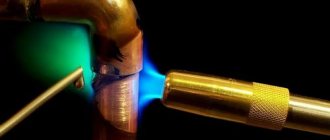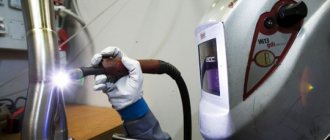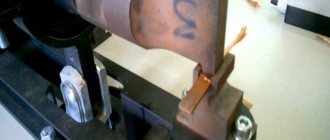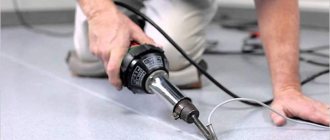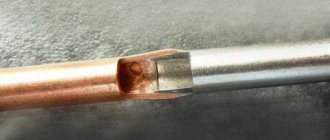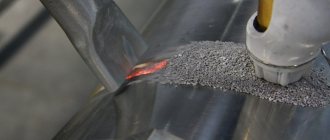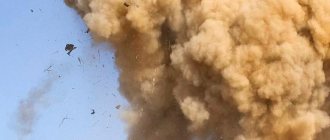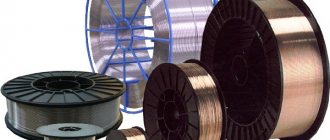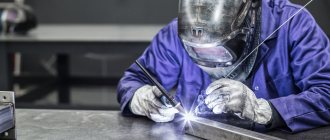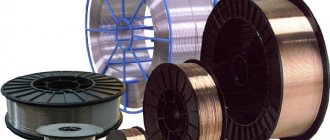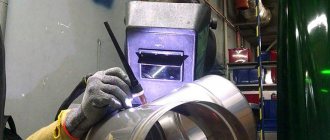Home page » Articles and reviews about tools and equipment » Science » Gas welding and cutting
WeldingTechnology
07.03.2020
185 Views
Evgeniy Maksimovich Kostenko Welding work: A practical guide for electric and gas welders
Abstract to the book “Welding: A practical guide for electric and gas welders”
Section three GAS WELDING AND CUTTING
Advantages and disadvantages of gas welding
Gas welding is a fairly simple technology that has many positive aspects:
- Possibility to carry out welding work offline. This does not require a powerful source of energy.
- Availability of simple oversized equipment that is easy to transport.
- The welding process is adjustable. The gas burner allows you to vary the operating high temperature, heating speed and fire angle.
And also great possibilities of use: processing is used to connect elements of products made of carbon steel, lead, copper, cast iron, brass, bronze, silumin, aluminum and its alloys.
There are also disadvantages when carrying out welding work:
- Large heating area, creating conditions for deformation of neighboring elements.
- The gas welding process is a high-risk job. Compressed oxygen and flammable mixtures require precautions.
- Gas welding is intended for metals up to 5 mm thick.
- Lack of gas burner automation.
- High demands on the welding profession.
Gas welding of metals and pipes
Types of gases used
Gas welding and metal cutting are aimed at local melting of a section of a part. Different types are used as combustible material. Their choice is determined by many factors. The main ones are the temperature of the fire and the amount of heat during combustion. There are several chemicals used in welding.
Oxygen
The most important element for soldering and cutting. It is used as a catalyst necessary to activate metal processing processes. It is characterized by the absence of color and odor, poor solubility in water and alcohol. Oxygen is an active chemical compound. It is kept in special containers under constant pressure. For oxygen welding, three types of technical gas are used. Each species depends on the purity of oxygen. This property affects the quality of parts processing.
Acetylene
The most common type, as it provides a high temperature compared to other flammable substances. It is formed on the basis of calcium carbonate with water. The chemical absorbs moisture from the atmosphere and breaks down under its influence, so the compound is stored in closed drums. Acetylene is explosive. However, this quality disappears if the mixture is dissolved in liquid.
Acetylene is one of the most common gases
Hydrogen
It is odorless and colorless. Becomes explosive on contact with air. The chemical element is stored in steel cylinders under pressure.
Coke gas
It is formed through the processing of coal. This is a colorless mixture of flammable substances with a pronounced hydrogen sulfide odor, which is transported through pipelines.
Natural gas
They are based on methane, extracted from the bowels of the Earth.
Gasoline and kerosene
Oil refining industry products. They appear as colorless liquids with an odor that evaporate easily. The gas burner feeds them through evaporators to produce steam.
Pyrolysis gas
It is subject to purification, as it consists of hydrocarbons and carbon monoxide. It is a by-product of oil refining plants.
Materials suitable for gas welding
Photo of the device of torches for gas welding
Gas welding is indispensable in industry, construction, and agriculture. It allows you to fasten a large number of metals.
Welding cast iron is necessary to eliminate defects, cracks, and broken parts of the product. The gas burner should have a small flame to avoid graininess of the weld seam.
Soldering bronze involves the use of a reduction flame. The work uses wire identical to the material being welded.
Copper processing does not require a gap between the edges. This is due to the fluidity of the material, which can complicate the gas welding process.
Carbon steels can be joined using different welding methods. The seams are made coarse by using low carbon steel wire.
Necessary equipment for gas welding
Gas welding equipment is used to join or cut metal elements under high temperature. It involves the use of different types of devices and accessories, depending on the type of work performed. Several components are used to process metal.
Water or liquid seal
Protects parts of devices from the backlash of the welding flame. This can happen when the gas flow rate is less than the combustion speed, or when the burner mouthpiece passages are clogged. All generators are equipped with this safety device.
Gas cylinders
Special cylindrical tanks with valves for storing and transporting chemicals. You can tell what type they contain by color.
Gas cylinders for welding
Gearbox
Reduces gas pressure or keeps it at a certain level. The device is available in direct and reverse action. This is an important element of gas equipment that determines the performance of the entire system. There are different types of devices, including an oxygen reducer. It is adapted to aggressive environments and has blue markings.
For gas welding, as a rule, the simplest single-chamber gearboxes are used
Gas hose
Provides supply of flammable liquids. It is made using special technology. This is a multi-layer product that can withstand aggressive environments, with an internal diameter of no more than 16 mm. Depending on the category, hoses are marked red, yellow and blue.
Gas hoses
Gas-burner
It is the main part of welding equipment. It produces a flame, which is necessary for heating and melting metal. By design, the product comes in two types: injection and non-injection. The gas burner operates at different powers. The choice depends on the amount of gas supplied per unit time.
Gas burner diagram
Special table
Increases the welder’s work convenience, as it performs several functions:
- fixes workpieces;
- stores auxiliary tools;
- is a ground loop.
The design may have a rotating or static tabletop.
Welding table diagram
The most popular methods
Welding in the lower position.
Gas welding methods can be described and listed in several thick volumes.
Let's take the most common of them:
Left welding
The left-hand method of gas welding is the most common among craftsmen of any qualification. Used to join metals with thin edges and low melting points. Left and right welding are two sides of the same coin, it’s easy to remember.
Right welding
The right welding method is suitable for working with metals with a thickness of more than 3 mm and high thermal conductivity. It should be noted that the weld seam during right-hand welding is of higher quality due to better protection of the metal by the flame.
The use of flame heat with the right method is more economical, and the process speed is almost 20% higher. To the same piggy bank of advantages you can add savings in gas costs of about 10%.
The filler wire must be taken with a diameter that is exactly half the thickness of the metal workpiece. The wire cannot be thicker than 8 mm.
Welding using through bead
This gas welding technology involves the gradual, step by step, movement of the flame to melt the upper edge of the hole in the workpiece and apply a layer of molten metal to the lower edge of the same hole.
First, the metal sheets are fixed vertically, leaving a gap between them half the thickness of the workpiece itself. The seam is formed in the form of a roller, which connects the parts. It is dense, without any pores or slag residues.
Welding using baths
Here the name speaks for itself. The principle of the method is the formation of more and more new pools along the seam. As soon as one of them is formed, the end of the filler wire is inserted into it, melts there, and then moves to the reduction section of the burner fire.
Meanwhile, the nozzle mouthpiece moves further along the seam - to the next section. Each new bath overlaps the previous one by approximately one third of the wire diameter.
This method is used to connect thin sheets when it is necessary to make butt or corner types of seams. This is a favorite type of welding for pipes made of low-alloy steel or low-carbon alloys.
Multilayer gas welding
It is used for very critical types of work, as it is characterized by rather low productivity, and welding gases are required here in large volumes - the method is not cheap. In it, the lower layers are annealed during surfacing of the upper and subsequent layers.
The result is excellent forging of each layer before the formation of the next seam. This method significantly improves the quality of the weld metal.
The process occurs in short sections. Pay special attention to cleaning the surface of the underlying layer before applying the next one.
Oxidizing flame and deoxidation welding
Cylinders for gas welding.
This technology was created for joining parts made of low-carbon steel alloys. The flame here has a sharply oxidizing character, as a result of which iron oxides are formed in the weld pool. If there is oxidation, so-called deoxidation is also necessary.
This is achieved using a special filler wire with high proportions of manganese and silicon. An excellent method with productivity 10% higher than other methods.
Gas cutters
Dismantling metal structures and cutting rolled products is impossible without a gas cutter. Models of such a device have the same operating principle, but differ in size, design, and the presence of additional parts. Using a gas cutter, you can work with workpieces of large thickness. Cutting occurs due to the fact that the combustion temperature is less than the melting temperature.
The process is conventionally divided into periods:
Gas cutter
- The treated area is heated to the desired temperature. To produce a flame, oxygen is mixed with a flammable substance in a certain dosage.
- Oxygen promotes deoxidation of the metal, combustion products are removed from the working area.
There are two types of gas cutter design:
- Injection - two-pipe, when technical oxygen is divided into two streams.
- Injectorless, or three-pipe, in which the oxygen and gas flow moves through different tubes, mixing inside the head.
How to use a plasma cutter?
Experienced carvers have formulated a number of recommendations to make it easier for beginning craftsmen to master the technology:
- strictly maintain a constant distance from the burner to the workpiece;
- if necessary, use a stop that is attached to the side of the burner and limits the gap;
- operate the burner evenly, without jerking, at a given speed;
- monitor the perpendicularity of the plasma beam to the surface of the part; deviations lead to a decrease in the quality of the cut surface;
- monitor the beam of sparks flying from the back side of the part; if there are few of them or they disappear, the metal is not completely cut through and the cutting mode must be adjusted;
After completing the cut, the torch must be tilted to allow the gases accumulated in the hose to escape.
Technological process of gas cutting
In the manufacture of metal structures, not only gas welding is used, but also metal cutting. It allows you to work with the following workpieces:
Gas cutting
- discs, rings;
- contour elements combining straight and curved lines made of steel up to 200 mm thick:
- parts of complex configuration;
- sheets more than 4 mm thick;
- channels from No. 16;
- I-beams from No. 20.
To obtain a high-quality cut, the metal surface is first cleaned of dirt, paint, oil or rust. Metal cutting is a thermal processing method divided into stages:
- The heater brings the temperature to 1100 0C.
- A gas burner supplies oxygen to the work area.
- The jet, in contact with the metal, ignites. The flame core should be located at a distance of 1 to 1.5 mm from the surface to be treated.
- Under stable gas supply conditions, the flow easily cuts the workpiece. The speed of the jet depends on the chemical composition of the material being cut.
Welding methods
Impact of steel impurities
The impact of steel impurities on the continuity of the gas cutting process directly depends on their percentage:
- Aluminum. The acceptable level is 0.5%.
- Copper. An impurity content of up to 0.7% of the total mass does not affect the process.
- Vanadium, phosphorus, sulfur. They do not have a negative effect at acceptable values.
- Tungsten. Does not interfere with cutting continuity up to 10%. A higher percentage makes the work difficult, at 20% the process is interrupted.
- Molybdenum. Allowed content is 0.25%.
- Nickel. The upper limit is 7-8%.
- Chromium. Maximum – 4-5% negative impact. An increased level sharply worsens cutting conditions. Requires the use of flux.
- Silicon. With standard indicators it does not interfere with the process. At 4% cutting is not possible.
- Carbon. Indicators range from 0.4% (norm) to 1-1.25% (work stoppage).
- Manganese. Standard – up to 0.4%. As it increases, cutting becomes more difficult; when it reaches 14%, it becomes impossible.
Safety precautions
Gas welding and cutting cannot be done without following safety regulations. While working, a welder is exposed to all sorts of potential hazards. Comprehensive precautions:
The following protection is needed from electric shock:
Safety instructions
- Grounding the device.
- Insulation of conductive parts of equipment.
- Dry, undamaged clothing.
- Exclusion of work in wet weather.
Eye protection requires the use of a special mask with light filters.
Gas welding poses a risk of burns, explosions and fires. The following will help you avoid an emergency:
- Equipment for workwear.
- Absence of open combustible and flammable substances in the work areas.
- Availability of fire extinguishing equipment.
- Compliance with the technological regime.
The following are used against poisoning by toxic fumes:
- Respirators.
- Effective ventilation in the room.
- Masks similar to gas masks.
Abstract to the book “Welding: A practical guide for electric and gas welders”
The book contains general information about welding, welded joints and seams, electric and gas fusion welding, gas welding and cutting. Devices, equipment and equipment for arc and gas welding, surfacing and cutting are briefly described, techniques for making various welds, and issues of quality control of welded joints are discussed. Information about promising types of welding is provided. For professional training and advanced training of welders, students of vocational schools and educational institutions, as well as for craftsmen and engineering personnel.
Other books by the author on Litres
